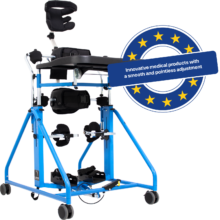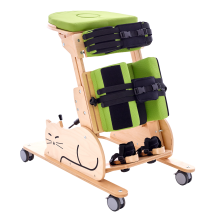INDICATIONS
It is recommended in the following cases:
- Cerebral palsy (CP) – various types and forms.
- Brain and spinal cord injuries of various etiologies with limb paresis, severe balance disturbances, and coordination impairments.
- Demyelinating diseases (multiple sclerosis – MS, amyotrophic lateral sclerosis – ALS, and others).
- Meningocele.
- Muscle diseases with paresis and paralysis (including dystrophy, myasthenia gravis, polymyositis).
- Genetic syndromes with limb paresis.
- Degenerative and metabolic diseases of the nervous system.
- Degenerative and rheumatic joint diseases.
- Other diseases with limb paresis, paralysis, and musculoskeletal impairments.
- After injuries, following traumatic brain injuries or spinal cord injuries with limb paresis and paralysis, particularly with quadriplegia (as part of the rehabilitation process or as permanent orthopedic support).
CONTRAINDICATIONS
During standing process, the person being stood must be observed. In case of side effects such as paleness, sweating, or fainting, joint overloading and resulting body deformations, the therapy should be stopped. Further steps should be consulted with a specialist doctor or physiotherapist who prescribed the aid.
Absolute contraindication to standing therapy is the critical condition of the user.
Relative contraindications to standing therapy:
- resting arterial hypertension above 200/110 mmHg, pulmonary hypertension, heart rhythm disorders, unstable asthma, unstable metabolic disorders, moderate stage of heart valve disease.
- Any condition, such as healing fracture or severe osteoporosis, that prevents weight-bearing in any way.
- Fracture with incomplete healing, unless approved by a doctor.
- Postoperative joint load restrictions.
- Pain associated with standing in the stander (caused by dislocation or hip dislocation, excessive stretching of soft tissues, excessive pressure). Dislocation or dislocation of the hip joint without pain is not a contraindication.
People with significant flexion in the hip or knee joints, as well as with ankle joint contractures, may not be able to use the stander. Caution should be taken to ensure that the position in the device does not cause excessive pressure or stretching of the diseased areas of the body. In such cases, standing therapy may be contraindicated until a greater range of motion is achieved in the contracted joints.
For individuals with impaired circulatory system (resting arterial hypertension above 200/110 mmHg, pulmonary hypertension, heart rhythm disorders, moderate stage of heart valve disease); respiratory system (unstable asthma) and unstable metabolic disorders, close monitoring of the user during standing position is necessary to prevent serious complications. This includes particularly monitoring blood pressure, heart rate, and any symptoms of orthostatic hypertension.
 Stable structure
Stable structure 24-month warranty
24-month warranty Easy to use
Easy to use


















